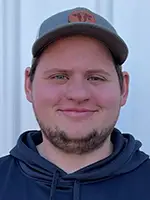
Automated milking systems: Why it was right for us and might be right for you
 Laufenberg Farms Waunakee, owned and operated by Fred and Dave Laufenberg, is located just outside of Madison, Wisconsin. The farm sits alongside one of the main highways leading into the city. It currently encompasses 280 milk cows, 600 owned acres, and a farrow-to-finish hog enterprise with 120 sows and 3,000 hogs marketed annually.
Laufenberg Farms Waunakee, owned and operated by Fred and Dave Laufenberg, is located just outside of Madison, Wisconsin. The farm sits alongside one of the main highways leading into the city. It currently encompasses 280 milk cows, 600 owned acres, and a farrow-to-finish hog enterprise with 120 sows and 3,000 hogs marketed annually.
More than a decade ago, the Laufenbergs were already feeling the pinch of a tight labor market as they competed with Madison jobs for quality employees. They were also milking cows in a “tired” stall barn, requiring multiple switches to milk the whole herd. Investing in the future of their farming operation, they transitioned to an automated milking system (AMS) 11 years ago.
Dave’s son, Luke, has now joined the farm full-time and “technology implementer” is one of his many roles. Luke shared the benefits of AMS his family has seen during his presentation at the Vita Plus Midwest Dairy Conference.
He explained the farm had a limited footprint to use as its proximity to Madison made land expensive and hard to come by. In addition to a new dairy barn, the farm needed a new calf barn. They built a new cross-ventilated barn with eight rows and slatted floors over a vented pit. It’s located up the hill from the original stall barn.
“Moving dirt and site preparation was significant,” Luke said.
With a good local DeLaval dealer, the Laufenbergs decided to install four DeLaval robots. Initially, the barn was set up for a milk-first system. However, Luke said the cows were “bunching up” in the holding pen and spending too much time standing, so they soon switched to a feed-first semi-guided system. Now cows do not stand in the holding pen for very long. During milking, cows receive a very basic pellet with excellent durability that holds up in the auger system and humid conditions. The overwhelming majority of their nutrition comes from the total mixed ration.
The Laufenbergs retrofitted the old stall barn into a calf barn with two automated calf feeders. Calves are fed milk replacer; they are first backgrounded in individual pens before transitioning to the group pens and autofeeders. The barn is also used to house weaned calves.
The Laufenbergs were early adopters of AMS and autofeeder technology, and Luke said the price of robots has come down since they installed them. He said most cows were adaptive to the robots; stubbornness to use the robots was a factor in culling decisions. Luke said the robots presented a learning curve for the team as well.
“A lot of work, patience and cool heads were needed,” he recalled.
After 11 years, Luke said the maintenance has been manageable, but a good relationship with the dealer was essential. Dealership staff took the time to teach and train the Laufenbergs on proper maintenance, which has helped them manage cost through the years. Routine maintenance includes new inflations, rubber parts and cleaning detergents.
Prior to the robots, the farm had three outside employees. Today, the Laufenbergs rely on very limited outside labor. Luke said two people handle all the cows and he spends a significant amount of time managing data versus the cows.
A new technology now adds to that data. The Laufenbergs recently installed a somatic cell counter that measures actual somatic cell count versus conductivity. They are in the process of perfecting the technology and will be able to use it to detect the early stages of milk quality issues.
In the 11 years since they adopted the robots, the Laufenbergs have improved average per-cow production from 60 pounds to 95 pounds. Luke said they are always looking for new opportunities to improve. One of the items on his wish list is a separate robot for special needs cows to eliminate any risk of contamination.
Luke said the farm’s future will also include more focus on sustainability as it continues to grow its cover crop practices. Because the farm is so visible to consumers, the Laufenbergs are committed to “maintaining their social license” by presenting a well-cared-for farm that consumers expect to see as they drive by.
“We always want to find our next diverse opportunity,” Laufenberg said, “and we challenge you all to do the same.”
Click here to download Laufenberg’s presentation from the 2022 Vita Plus Midwest Dairy Conference.
| Category: |
Business and economics Dairy Performance Equipment Facility design Technology and data management |

